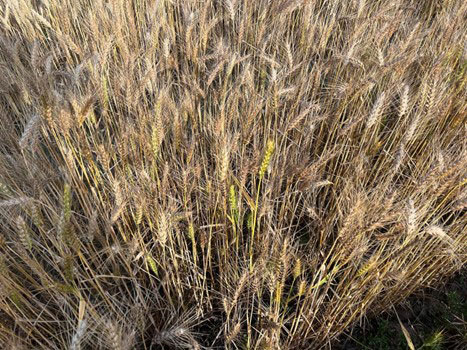Rainfall and cooler temperatures during the past few weeks have resulted in a flush of late, green tillers in the wheat over much of Kansas (Figure 1). This can create a problem, especially for wheat that is approaching harvest maturity. A question that usually arises when this happens is: Should I wait to start harvesting until most of the green heads have matured, or start harvesting anyway?

Figure 1. Wheat plants near Manhattan, KS, showing later-emerged tillers during the 2024 growing season as of June 13. Notice the shorter and later heads in the middle to lower portions of the plants. Photo by Luis Pradella, MS student, K-State Research and Extension.
The answer to this question depends on a number of factors, including:
- How advanced are the main tillers in relation to the late-developed tillers?
- What percent of the total heads in the field are composed of late-emerged heads?
- What will the weather be between now and harvest?
These factors will help define whether late-developed heads can actually contribute significantly to the final yield or whether they will only be a nuisance. For example, if wheat in the most advanced heads is already well into the grain-filling stages of development while many late-produced tillers may still be in the boot, waiting on the late-emerged tillers to harvest will likely not be feasible. Alternatively, in Figure 1, the main tillers are near maturity but still have fairly high moisture content, while the late emerged tillers are already well into the soft dough stages of development with good grain weight potential. Thus, in this case, it likely pays to wait until the late-developed ones are ready to be harvested.
In cases where these tillers don’t amount to more than 5% of the total amount of heads in the field, producers should not delay harvest because of the green tillers, as they won’t add much to the final yield. Additionally, should the temperatures increase to more normal Kansas grain-filling weather in the near future, these late-developed tillers may be more exposed to heat stress. This would potentially result in lower test weight and shriveled kernels. So, producers should start harvesting as soon as the bulk of the field is ready. With varieties that tend to shatter easily, producers should start harvesting as soon as the field reaches 15% moisture.
If we have another ~2-3 weeks of below-average temperatures and above-average moisture and the green tillers make up for a large number of the heads in the field, waiting to harvest until all heads ripen may be justified—but the chances here are slim. For most cases, it will probably be best to just start harvesting when the majority of heads are ready to go since waiting for the green heads to ripen might lead to the shattering of the more mature heads.
Producers should be aware that the grain in the green heads may cause some storage problems. It’s never easy to manage a late flush of green shoots in wheat. Unfortunately, there’s no clear-cut answer, nor is there one best management strategy to fit all situations.
Romulo Lollato, Extension Wheat and Forage Specialist
lollato@ksu.edu
Tags: wheat harvest late tillers